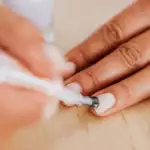
Our editors have independently chosen the products listed on this page. If you purchase something mentioned in this article, we may earn a small commission.
August 16, 2021 — 13:06 PM
Want to keep your flower garden looking neat and tidy? Deadheading, that is: removing dead or spent flowers, is an essential step. Beyond helping your yard look better, deadheading can also make it healthier and more productive.
Here, gardening experts share everything you need to know to master the simple technique.
“Regular deadheading maintains a plant’s appearance and improves its overall performance,” Kelly Wilkniss, gardening expert and host of My Soulful Home on Smart Healthy Green Living, tells mbg.
Once flowers start to fade, plants start to turn their attention to generating seeds instead. “At that time the plant’s energy is focused on the development of the seeds rather than the flowers,” Wilkniss explains.
By removing dead flowers, you’re telling your plant to keep producing new flowers instead of putting all its energy into seeds. “This results in healthier plants and a second or perhaps continual blooms,” she adds.
In short, deadheading helps your garden produce more flowers and stay in bloom for longer, which is great for you and your local pollinators.
Flowers you should deadhead.
A wide variety of annual and perennial plants can be deadheaded throughout the growing season. Here are a few that will appreciate the occasional cleanup:
- Butterfly bushes
- Coleus
- Cosmos
- Daisies
- Delphiniums
- Hydrangeas
- Marigolds
- Roses
- Yarrow
- Zinnias
Flowers you don’t need to deadhead.
probiotic+
Tackle your gut issues now, so you don’t have to think about them later.*

There are some plants that don’t need to be deadheaded, like ones that only bloom once a year. You can remove the dead flowers on these for aesthetic reasons, though doing so won’t promote any new growth.
Some plants are also self-cleaning. Their flowers naturally fall once spent, making deadheading unnecessary. And then there are the varieties that you actually want to go to seed, like edible plants and flowers that have attractive seed pods.
Sabine H. Schoenberg, the CEO and co-founder of Smart Healthy Green Living, adds that some plants must reseed in order to bloom the following year and really shouldn’t be deadheaded. When in doubt, double-check that yours will appreciate the trim.
Here are a few varieties that Schoenberg and Wilkniss say don’t need deadheading:
- Angelonias
- Astilbes
- Begonias
- Calibrachoa
- Impatiens
- Lantanas
- Nemesias
- Peonies
- Sedums
- Vincas
If a plant has a delicate enough stem, you can just remove its spent flowers using your hands. Simply pinch on the spot just below the spent flower, above the first set of full, healthy leaves, and pull it off.
Flowers that have thicker, woodier stems, like roses, will require sharp scissors or garden snips. The same method applies: Cut the stem directly below the spent flower, above the healthy leaves.
Deadheading is super easy, though it can get tedious depending on the size of your garden and the types of flowers you’re growing. For plants that have lots of small buds, Wilkniss says that using shears to cut multiple flowers at a time can help the process go faster.
Once you see a large patch of faded blooms, simply “shear away the top few inches of the plant to remove the spent blossoms.” This will help the entire plant grow back stronger.
Once you have your pile of spent flowers, add them to your compost bin so their nutrients can return to the land with time.
You should deadhead throughout the growing season, whenever you see flowers fading. “Deadheading starts after the ‘first waves’ of flowers,” says Schoenberg. “It should be repeated whenever possible throughout the flowering cycle on those plants that benefit.”
Where on the plant should I cut?
While it depends on the plant, yogi and plant lover Roos Kocken says you’ll usually want to cut just below the dead flowers. If a flower has an especially long stem or everything on the stem is dead, feel free to cut the entire thing off. Just try not to snip any healthy-looking leaves, as this might affect the plant’s ability to regrow new flowers.
How do I make deadheading less tedious?
Like weeding, deadheading can get monotonous. You can shake things up by trying these routines that turn gardening into a workout, reframing deadheading as a meditative activity, or recruiting a friend or family member to join you. (This is one garden task that kids could help with!)
Once you get the hang of deadheading, you might be surprised by how much the simple method can help your garden grow, especially when paired with other pruning techniques like pinching back. Ready? Grab those scissors or gardening gloves and get out there to clear away the old and make way for the new.
Want to learn how feng shui can help you create a high-vibe home and set powerful intentions to manifest your dreams? This is feng shui the modern way – no superstitions, all good vibes. Click here to register for a free session with Dana that will give you 3 tips to transform your home today!
https://www.mindbodygreen.com/articles/deadheading







